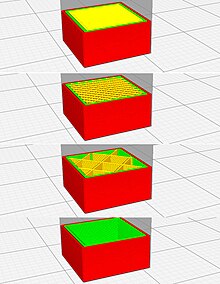3D Printing/Slicing Software

Slicers
[edit | edit source]A slicer converts a 3D model of an object into layers that a 3D printer can understand.
Many slicers include convenience features. A common example includes printer and material presets.[1] Some FFF slicers include uncommon features that help with complex geometry and print reliability.[2]
SLA slicers produce different support structures from FFF slicers.[3]
Infill
[edit | edit source]
Infill determines the amount of material on the inside of a print.
A number of creative infill patterns can be used for different purposes, such as 3D infills[4] and gradient infills.[5]
GCode
[edit | edit source]Many 3D printers use GCode for instructions on operation. However not all generated GCode is the same.
There are a number of software packages oriented around GCode. Some software analyses GCode and provides helpful information about a print.[6] GCode post processors can improve print speed and quality.[7] Non-planar GCode can also improve 3D printing results.[8][9]
Slicer features
[edit | edit source]
Layer height
[edit | edit source]Some slicers support variable layer height, allowing for the printer to slow down on detail heavy areas for better quality, and speed up printing for less detailed areas.[10]
Pausing
[edit | edit source]Some slicers allow prints to be paused to allow operators to swap materials partway through, or to add things like magnets to the internals of the print.[10][11]
References
[edit | edit source]- ↑ "PrusaSlicer - Prusa3d.com - 3D printers by Josef Prusa". Prusa3D - 3D Printers from Josef Průša. Retrieved 29 November 2020.
- ↑ "Pathio: New 3D Slicer From E3D". Hackaday. 24 February 2019. Retrieved 29 November 2020.
- ↑ "How to slice 3D objects for the Original Prusa SL1 [updated with video guide]". Prusa Printers. 19 June 2019. Retrieved 6 November 2020.
- ↑ "3D Internal Structure For Better 3D Printed Objects". Hackaday. 10 June 2016. Retrieved 6 November 2020.
- ↑ "Gradient Infill Puts More Plastic Where You Want It". Hackaday. 21 January 2020. Retrieved 6 November 2020.
- ↑ "GCode Analyzer/Visualizer by hudbrog". www.thingiverse.com. Retrieved 6 November 2020.
- ↑ "This GCode Post-Processor Squeezes Lines Into Arcs". Hackaday. 3 November 2020. Retrieved 6 November 2020.
- ↑ "3D Printering: Non-Planar Layer FDM". Hackaday. 27 July 2016. Retrieved 6 November 2020.
- ↑ "makertum/non-planar-layer-fdm". 6 November 2020. Retrieved 6 November 2020.
- ↑ a b "PrusaSlicer 2.2.0 is out! Hollowing, support for 3rd party printers and more!". Prusa Printers. 25 March 2020. Retrieved 6 November 2020.
- ↑ "Change Filament At Z Cura Plugin by rawlogic". www.thingiverse.com. Retrieved 6 November 2020.